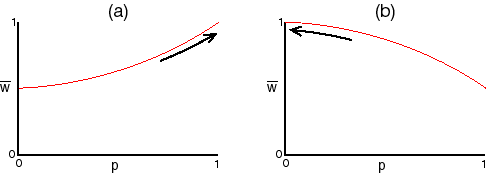Know the meaning of the following terms:
Radiometric dating
Isochron dating
Archean
Proterozoic
Phanerozoic
RNA world
LUCA
Stromatolite
Archaea
Ediacarin
Kimberella
Trace fossil
Cambrian explosion
Mean heterozygosity
Gametic disequilibrium
Haplotype
Genetic drift
Coalescent
Molecular clock
Fixation (of an allele)
Effective population size
Selection
Marginal fitness
Mean population fitness
Here are some practice questions
(Scroll down for answers.)
1) List the periods of the phanerozoic and their boundary dates.
This question will definitely be on the exam
2) Draw a phylogeny showing the relationships between: Chordates, Mollusks, Annelids, Echinoderms, Fungi, Arthropods, Plants, Cnidarians, and Nematodes.
3) Describe three properties of RNA that make it a likely candidate for the genetic material of the first life forms on earth.
4) Put the following events in the order in which they occurred (first to last).
(a)First Flowering Plants
(b)First Amniotes
(c)First Mammals
(d)Small Shelly Fauna
(e)Initial increase in atmospheric [O2]
(f)First vascular plants
(g)First stromatolites
(h)Extensive grasslands
(i)Cambrian Explosion
(j)Extinction of non bird dinosaurs
5)a) What is meant by the term "molecular clock"?
b) Most molecular clock studies use only silent DNA substitutions in their analysis - explain why.
6) Consider three loci, A, B, and C, each with two alleles, in a population having the following 4 haplotypes at the frequencies indicated:
25% A1B1C1, 25% A2B2C2, 25% A1B2C1, 25% A2B1C2
(a) Which pair(s) of loci are in gametic disequilibrium?
(b) How would selection favoring A2 at the A locus alter allele frequencies at the B locus? At the C locus?
7) Some insects exhibit "boom and crash" population dynamics, in which the population grows very fast to a large size (the "boom") and then crashes to a very small size, before repeating the cycle. Explain what effect this should have on effective population size.
8) What are Stromatolites? In what significant way did they and their relatives alter earth's environment for future inhabitants?
9) Explain how drift, though a random process, leads to certain predictable outcomes for the fate of neutral alleles in a population.
10) Explain how we can infer the existence, in the Cambrian, of groups (or lineages leading to them) that do not fossilize.
11) Sketch the curve of mean population fitness as a function of allele frequency for
both of the following sets of genotypic fitness values, and indicate where selection
will drive the population in each case:
a) w11 = 1, w12 = 0.5, w22 = 0.5
b) w11 = 0.5, w12 = 1, w22 = 1
12) In which of the cases above would you expect more variation to be maintained at mutation-selection equilibrium? Explain.
Answers
1) See lecture notes.
2)
3) Any 3 of:
Can act as an enzyme.
Can catalyze its own replication.
Can bind ATP.
Found in all living organisms.
4) See lecture notes.
5) a) Estimating the time since the common ancestor of two organisms or species by looking at the genetic distance between them. [Or: measuring time by counting changes in DNA, RNA, or proteins]
Note: The answer must make some mention to measuring time, rather than just genetic distance.
b) The molecular clock works only if the rate of molecular evolution is constant over time. We expect this to be the case for silent substitutions since these are selectively neutral - meaning that the rate of evolution is just the rate of appearance of mutations times their probability of fixation, or: rate = 2Nun 1/(2N) = un.
6)a) A and C are in gametic disequilibrium.
b) Selection favoring A2 will lead to no change at the B locus, but it will lead to an increase in frequency of C2 at the C locus.
7) Ne will be relatively small, much closer to the population size during a "crash" than to that during a "boom". This is because Ne is the harmonic mean of population size over time, and is thus most strongly influenced by small values. (Note: You do not have to use the appropriate equation for Ne in this answer, but doing so would allow you to answer more succinctly).
8) Stromatolites are large, pillow like, structures formed from layers
of photosynthetic cells interspersed with layers of sediment.
The organisms that formed stromatolites, along with other photosynthetic
cells, were responsible for the mass production of free Oxygen. This altered
the environment by making the atmosphere damaging to most large organic
molecules. It also set the stage for the evolution of more efficient energy capture through respiration.
9) Drift causes allele frequencies to change randomly over time. Because a frequency of 1 (fixation) or 0 (extinction) are absorbing states, a drifting allele will eventually hit one of them and subsequently stay there. We can thus predict that drift will tend to lead to a loss of genetic variation.
10) We need a well supported phylogeny that includes some taxa that have a good fossil record. If we observe, in the Cambrian, two taxa that diverged from one another after the non-fossilizable group branched off (as shown by our phylogeny), then we can conclude that the lineage leading to the non fossilizable group must have already branched off by that time. (A picture is not necessary for answering this question, but using one would make your answer clearer and more succinct).
11) The arrows indicate the direction of evolution under selection.

12) In case (b) selection becomes increasingly weak as a population approaches fixation of the A2 allele (which is favored in this case). We thus expect that mutation can maintain the deleterious allele at a higher frequency here than in case (1), where selection becomes stronger as we approach fixation of the favored allele.
Jul 8, 2021